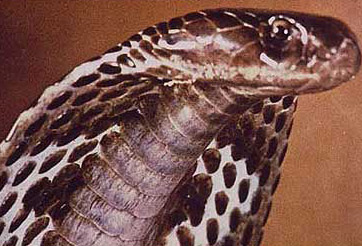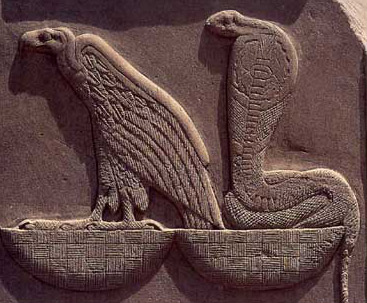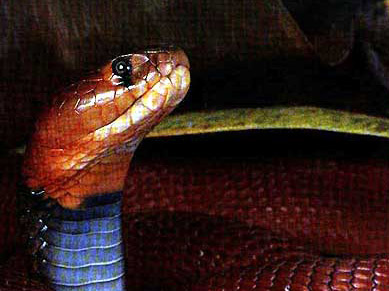The Snakes of Egypt
by Jimmy Dunn

Editor's Note: I have been to Egypt many more times than I can count, visiting just about every corner of the country. During that time, I have seen one snake, belonging to and under the control of a snake charmer. Certainly there are snakes in Egypt, but I have not seen them pose any problem to tourists. That is not to say that tourists, particularly those who visit some of the more exotic places such as the Western Desert and the Sinai mountains, should not keep a careful eye out. Egypt contains many snakes, but snakes are shy animals that attempt to avoid humans, and therefore are rarely found in populated areas that tourists visit.
Historical Overview

Snakes were found throughout ancient Egypt, including the desert sands, in old walls, in fields, by the Nile and in its swamps, on threshing floors, in houses and in livestock enclosures and pastures. Poisonous snakes would have posed a threat to humans and domestic animals alike. Hence, the Egyptians had somewhat of a love/hate relationship with snakes. While they were dangerous, they were also viewed, for example, as a protector to the King, but also a demon of the underworld.
A papyrus in the Brooklyn Museum which served as a manual for a doctor treating snakebite reveals that the Egyptians had an intimate knowledge of snakes. Although the beginning of the papyrus is lost, it would have listed the names of some thirty-seven. At least thirty-six species (some sources say 34, 37, or 40, of which an estimated seven are poisonous) have been identified in modern Egypt, but the ancient typology most likely did not correspond exactly to the modern ones. The papyrus gives a physical description of each snake and its habitat, along with precise descriptions of the symptoms produced by each snake's venom, whether or not the bite is mortal, and the name of the god or goddess of which the snake is considered to be a manifestation. Following the list of snakes is a list of remedies to cure bite victims. Some of the remedies are specific for certain types of snakes, while other were for specific symptoms. These remedies included emetics, compresses, unctions, massages, incision of wounds and fumigations. There were also magical incantations that were spoken over the remedies. The ingredients in the remedies include liquids and substances of mineral, animal and vegetable origin. The most common ingredient is onion, still used frequently in Egyptian folk medicine today to treat snakebite.

One of the poisonous snakes the Egyptians feared most was the horned viper (Cerastes cornutus and Cerastes cerastes, also known as the sand viper). When the horned viper attacks, it rasps its coils together before springing forward. The rasping sounds like the letter f, and the horned viper was used as the hieroglyph to write the sound (fy is the Egyptian word for "viper" as well).
The Pyramid Texts allude repeatedly to the menace of serpents, and they recur in religious texts throughout ancient Egyptian history. First attested in the First Intermediate Period, the snake god Apophis (Apep) was considered the enemy of order, or Ma'at.

As early as the reign of Ramesses II, Apophis became the subject of a ritual recorded in several magic books. During religious processions and lunar feasts, images of Apophis were fashioned from papyrus and wax and then subjected to various tortures, representing the triumph of Re and Ma'at over the chaos symbolized by Apophis. However, while Apophis was the nemesis of the sun god, the powerful serpent deity, Mehen, protected the sun.
However, not all snakes were considered bad. Deities associated with poisonous snakes were sometimes even considered beneficial. The goddess Renenutet often appeared in the form of a hooded cobra. Her name is derived from an Egyptian word meaning, "to nurse," and she was closely associated with the fertility of fields, and consequently was considered the goddess of the granary.

Offerings of the first fruits were made and hymns sung to a statue of Renenutet when grain was brought to the granary or when wine was stored in the cellar. She also had close ties with woven material and personified linen. Although her name first appears in the Old Kingdom in the Pyramid Texts, she is not depicted in art until the New Kingdom. She was worshipped throughout Egypt, but her cult was of particular significance in the Fayoum.
The snake goddess Meretseger personified the pyramid shaped peak that rises above the Valley of the Kings. She may have been an object of a domestic cult in the nearby village of the royal tomb builders and their families at Deir el-Medina, because snake figurines were found during excavations, many of which were covered with cooking soot, suggesting she provided protection for the kitchen.

Certainly nonpoisonous snakes would have been considered beneficial to the household, as they are sometimes regarded today in Egypt, because they eat rodents.
The uraeus was the image of the Egyptian cobra (Naja haje), worn in the front of the king's headdress. Here the snake represents the snake goddess Wadjet, associated with the Lower Egyptian sanctuary of Buto. Her counterpart was the vulture goddess Nekhbet of Hierakonpolis in Upper Egypt. Wadjet acted as a mythical mother and midwife of the king. At Tuna el-Gebel, mummified cobras have been found amongst the millions of other animals in the great animal catacombs.

A creation myth explains how the uraeus came into being. The god Atum had created the god Shu and the goddess Tefnut, who represented air and moisture, and they had gone out into the world. Atum sent his eye out to fetch them, which it did, but when it saw that it had been replaced by the sun, it became furious and transformed itself into a cobra, which Atum appeased by placing it on his brow. Thus the uraeus came to be considered a protector of kingship.
Other snake deities include Denwen, a serpent god with dragon-like ability known from Old Kingdom times, Kebehwet (Kabechet), a celestial serpent who is mentioned several times in the Pyramid Texts and who was said to be the daughter of Anubis and the king's sister. Nehebu-Kau is first attested in the Pyramid texts and was regarded as a benign and helpful deity who assisted the deceased king in various ways. The serpent goddess Wepset appears to be one of the various identities of the fiery uraeus who guarded gods and kings and is first attested to in the Coffin Texts. The name Weret-Hekau was applied to several goddesses. In the Pyramid texts the name is associated with the divine uraeus and with the crown of Lower Egypt. Finally, Yam was a Semitic god that made its way into Egypt. He was known elsewhere as a tyrannical, monstrous deity of the sea and other bodies of water.
Winged snakes are depicted in Egyptian art and are found frequently in religious texts painted in the royal tombs in the Valley of the Kings. Wadjet was sometimes depicted as a winged snake. The Greek author Herodotus claimed to have seen skeletons of flying snakes when he visited Egypt.

It is not known how the idea of winged snakes originated, but among the suggestions that have been put forth are the resemblance of the posture of the snake's neck and anterior of its body to wings when it is excited, the fact that horned vipers throw themselves at their victims, or the resemblance of a shedding snakeskin to wings.
Snakes appear in several Egyptian literary works. A central character in the Story of the Shipwrecked Sailor is a cobra who saves the shipwrecked sailor and looks after him on his island in the midst of the sea for four months. At the birth of the eponymous character in the Story of the Doomed Prince, the fates decree that he will die as a victim of a snake, dog or crocodile. He escapes the first of these fates after his wife puts out some beer to attract the dangerous snake out of its hole. The snake drinks it, passes out and is hacked up by the woman.

Snakes in Egypt Today
In modern Egypt, the cobras are perhaps the most infamous. Myth and legend fueled by Shakespeare popularly lay the blame for Cleopatra's death on the asp, but this small viper is not found in Egypt. More likely, the true culprit clutched to her bosom was probably the Egyptian Cobra. Egyptian Cobras can reach a length of nearly two meters and are generally a uniform brown in color, though the shade varies considerably. Some individuals are marked with darker brown around the head. The famous hood is not apparent unless the animal is annoyed, whereupon it flattens the neck region and adopts its classic pose.

Two other species of cobra occur in the country. One is the uncommon Spitting Cobra, characterized by its black neck and unusual method of delivering venom. The other is the rare Innes cobra, only likely to be encountered in the northeast, and there only if one is very lucky, or perhaps unlucky. Other poisonous snakes include the vipers, such as the Horned Viper, the Saw Scaled Viper, which is very dangerous, and Burton's Carpet Viper, which is found in the Sinai and apparently mole vipers.

Most Egyptian snakes are harmless. The African egg eating snake is a widespread species with a range covering most of Africa and parts of Arabia. In Egypt it is restricted to the southern part of the Nile Valley. As the name suggests, it feeds on eggs and everything about it is geared to the consumption of eggs The Egg eating Snake is a very slender reptile, generally under a meter long and colored gray with black diamonds. Another helpful snake is the Sand Boa Eryx colubrinus), which is only a couple of feet long, but very deadly to the rodent population. Other unusual snakes include the Banded Snake (Coluber sinai) and the Hoogstraal's Cat Snake (Telescopus hoogstraali), both found in the Sinai.
References:
|
Title |
Author |
Date |
Publisher |
Reference Number |
|
Complete Gods and Goddesses of Ancient Egypt, The |
Wilkinson, Richard H. |
2003 |
Thames & Hudson, LTD |
ISBN 0-500-05120-8 |
|
Dictionary of Ancient Egypt, The |
Shaw, Ian; Nicholson, Paul |
1995 |
Harry N. Abrams, Inc., Publishers |
ISBN 0-8109-3225-3 |
|
Dictionary of Egyptian Gods and Goddesses, A |
Hart, George |
1986 |
Routledge |
ISBN 0-415-05909-7 |
|
Natural Selections (A Year of Egypt's Wildlife) |
Hoath, Richard |
1992 |
American University in Cairo Press, The |
ISBN 977-424-281-5 |
|
Oxford Encyclopedia of Ancient Egypt, The |
Redford, Donald B. (Editor) |
2001 |
American University in Cairo Press, The |
ISBN 977 424 581 4 |
|
Shaw, Ian |
2000 |
Oxford University Press |
ISBN 0-19-815034-2 |
|
|
Western Desert of Egypt, The |
Vivian, Cassandra |
2000 |
American University in Cairo Press, The |
ISBN 977 424 527 X |
Last Updated: August 21st, 2011

